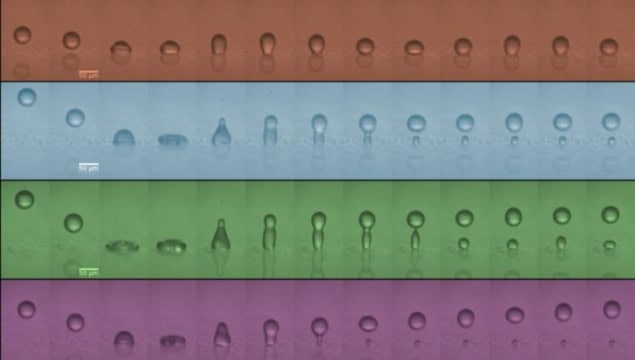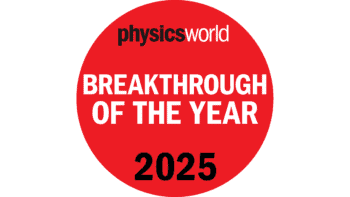
What happens when a microscopic drop of water lands on a water-repelling surface? The answer is important for many everyday situations, including pesticides being sprayed on crops and the spread of disease-causing aerosols. Naively, one might expect it to depend on the droplet’s speed, with faster-moving droplets bouncing off the surface and slower ones sticking to it. However, according to new experiments, theoretical work and simulations by researchers in the UK and the Netherlands, it’s more complicated than that.
“If the droplet moves too slowly, it sticks,” explains Jamie McLauchlan, a PhD student at the University of Bath, UK who led the new research effort with Bath’s Adam Squires and Anton Souslov of the University of Cambridge. “Too fast, and it sticks again. Only in between is bouncing possible, where there is enough momentum to detach from the surface but not so much that it collapses back onto it.”
As well as this new velocity-dependent condition, the researchers also discovered a size effect in which droplets that are too small cannot bounce, no matter what their speed. This size limit, they say, is set by the droplets’ viscosity, which prevents the tiniest droplets from leaving the surface once they land on it.
Smaller-sized, faster-moving droplets
While academic researchers and industrialists have long studied single-droplet impacts, McLauchlan says that much of this earlier work focused on millimetre-sized drops that took place on millisecond timescales. “We wanted to push this knowledge to smaller sizes of micrometre droplets and faster speeds, where higher surface-to-volume ratios make interfacial effects critical,” he says. “We were motivated even further during the COVID-19 pandemic, when studying how small airborne respiratory droplets interact with surfaces became a significant concern.”
Working at such small sizes and fast timescales is no easy task, however. To record the outcome of each droplet landing, McLauchlan and colleagues needed a high-speed camera that effectively slowed down motion by a factor of 100 000. To produce the droplets, they needed piezoelectric droplet generators capable of dispensing fluid via tiny 30-micron nozzles. “These dispensers are highly temperamental,” McLauchlan notes. “They can become blocked easily by dust and fibres and fail to work if the fluid viscosity is too high, making experiments delicate to plan and run. The generators are also easy to break and expensive.”
Droplet modelled as a tiny spring
The researchers used this experimental set-up to create and image droplets between 30‒50 µm in diameter as they struck water-repelling surfaces at speeds of 1‒10 m/s. They then compared their findings with calculations based on a simple mathematical model that treats a droplet like a tiny spring, taking into account three main parameters in addition to its speed: the stickiness of the surface; the viscosity of the droplet liquid; and the droplet’s surface tension.
Previous research had shown that on perfectly non-wetting surfaces, bouncing does not depend on velocity. Other studies showed that on very smooth surfaces, droplets can bounce on a thin air layer. “Our work has explored a broader range of hydrophobic surfaces, showing that bouncing occurs due to a delicate balance of kinetic energy, viscous dissipation and interfacial energies,” McLauchlan tells Physics World.
This is exciting, he adds, because it reveals a previously unexplored regime for bounce behaviour: droplets that are too small, or too slow, will always stick, while sufficiently fast droplets can rebound. “This finding provides a general framework that explains bouncing at the micron scale, which is directly relevant for aerosol science,” he says.
A novel framework for engineering microdroplet processes
McLauchlan thinks that by linking bouncing to droplet velocity, size and surface properties, the new framework could make it easier to engineer microdroplets for specific purposes. “In agriculture, for example, understanding how spray velocities interact with plant surfaces with different hydrophobicity could help determine when droplets deposit fully versus when they bounce away, improving the efficiency of crop spraying,” he says.

Sliding droplets generate electrical charge as they stick and unstick
Such a framework could also be beneficial in the study of airborne diseases, since exhaled droplets frequently bump into surfaces while floating around indoors. While droplets that stick are removed from the air, and can no longer transmit disease via that route, those that bounce are not. Quantifying these processes in typical indoor environments will provide better models of airborne pathogen concentrations and therefore disease spread, McLauchlan says. For example, in healthcare settings, coatings could be designed to inhibit or promote bouncing, ensuring that high-velocity respiratory droplets from sneezes either stick to hospital surfaces or recoil from them, depending on which mode of potential transmission (airborne or contact-based) is being targeted.
The researchers now plan to expand their work on aqueous droplets to droplets with more complex soft-matter properties. “This will include adding surfactants, which introduce time-dependent surface tensions, and polymers, which give droplets viscoelastic properties similar to those found in biological fluids,” McLauchlan reveals. “These studies will present significant experimental challenges, but we hope they broaden the relevance of our findings to an even wider range of fields.”
The present work is detailed in PNAS.



